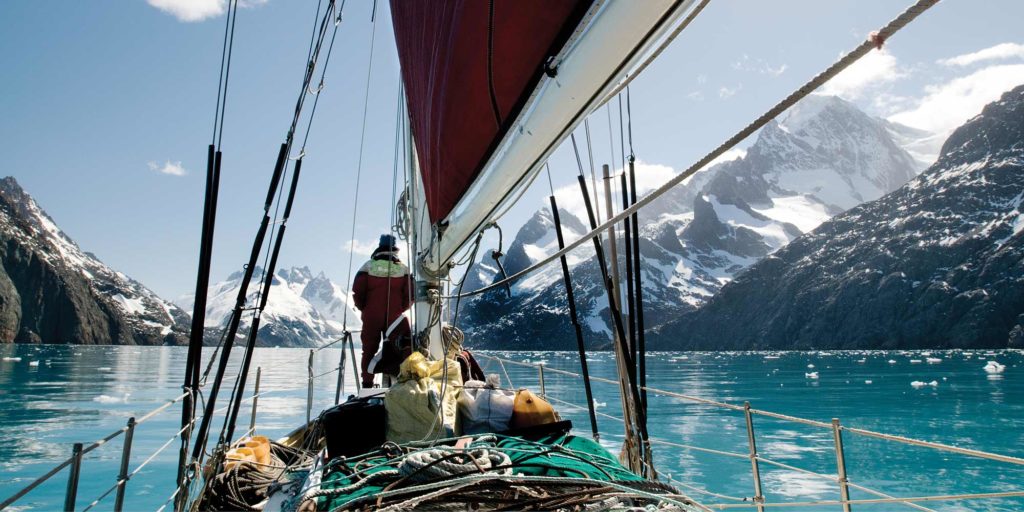
The Antarctic island of South Georgia is the most nerve-racking place I know. Along its spectacular coast — nearly 10,000 feet high in places, where hurricane-force winds can replace a flat calm in seconds — simply being there requires tenacity. Sailing away from the island is a kind of game of chance. Whether attempting the 800-nautical-mile upwind passage to the Falkland Islands or the 3,000-nautical-mile downwind one to Cape Town, South Africa, an oceanic gantlet of icebergs, fog and gales is unavoidable.
And getting there? That is also far from child’s play. On our Wanderer III, a 30-foot wooden boat with sextant and compass but no radar, weather forecasts or communication other than VHF radio, it’s pure psychology. Each phase of a voyage to the most fantastic island of the world is more than demanding.
When I first conjured up South Georgia as an idea, Kicki and I were still sailing in the Pacific. Later, in Cape Town, in 1997, after 10 years of being underway, a mere Atlantic passage separated us from a return to Europe. But I couldn’t get South Georgia out of my mind. I knew: If not now, then never. Rules and fees increasingly restrict the movements of curious sailors and simple boats like Wanderer III. Exploration has been replaced by tourism and orderly experiences, even at the far reaches of the planet.
So we recast our thoughts and actions. We sailed 55 days, first to Montevideo, Uruguay, for the cakes at the Cafe Rheingold, then on to a face-lift for Wanderer in Buenos Aires, Argentina, and finally to the Falklands — this last step in borrowed foul-weather gear. With our necks and backs suddenly no longer wet, we were encouraged to aim for South Georgia, after the winter.
On November 27, we had Wanderer shipshape for the passage into the cold, and had even stashed aboard some quebracho firewood from Argentina. The saloon table was in the forepeak; all four anchors and mooring lines were secured between the midship bunks. Diesel, kerosene and cocoa powder were topped up, and everything was ready; we just needed a forecast. So, in those pre-GRIB-file days, we contacted the met office. “Monday: Severe storm.”
RELATED: Arm Yourself For Cold-Weather Cruising
Actually, that suited us just fine. It gave us two or three days to properly say goodbye to a place and people we had grown very fond of over the year. In my irrational habit of pursuing chimeras, I even proposed a return: We’d beat back 800 nautical miles through the Southern Ocean, from South Georgia to the Falklands, I told folks. The conviction with which I announced this fooled even me.
On Saturday it blew just like normal, but not a storm. Sunday likewise. In fact, there was no storm in sight.
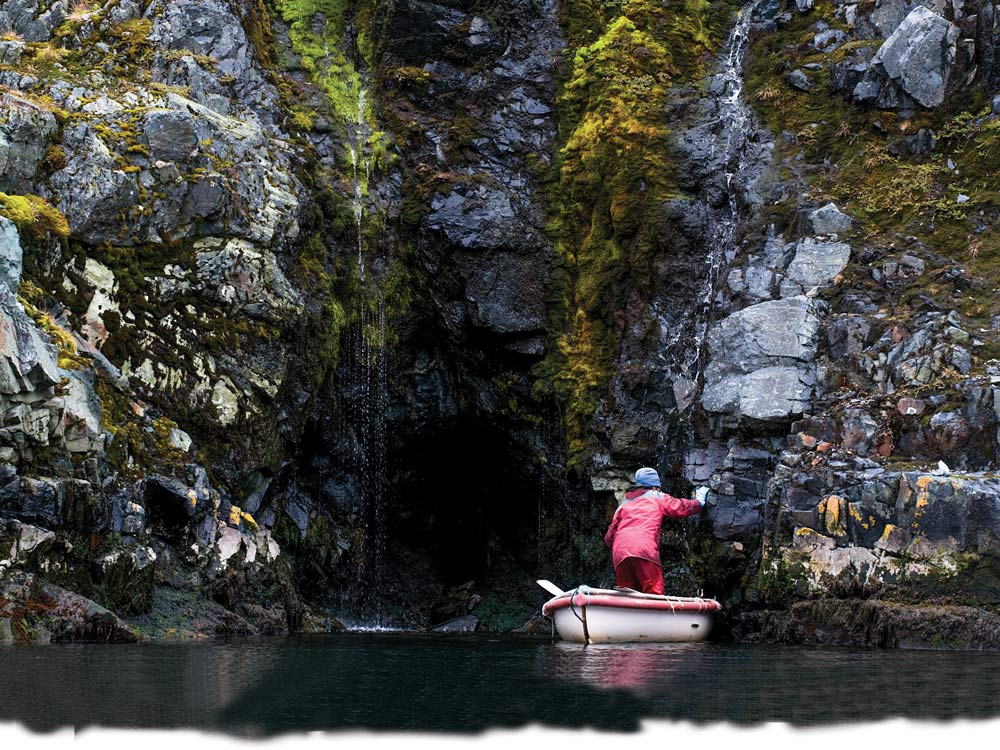
“Never be impatient in the Southern Ocean,” came the advice from, of all people, French navigator and sailor Philippe Poupon.
On Monday, finally, hurricane-strength winds swept all impatience into outer space. Even the oldest Kelpers, the Falkland locals, couldn’t remember seeing their harbor white-washed for four solid days. A Spanish fishing boat steamed up and down the cigar-shaped harbor for three of them because the anchor would not hold and coming alongside was totally unthinkable. A multistory Princess cruise ship couldn’t retrieve 200 of its 2,000 passengers from their shore leave, and required the help of a tug to reach open waters, where it held its position through the blow.
Wanderer, well secured with shore lines, heeled heavily. Stanley Harbour came to a standstill and my knees went weak — both in direct relationship to the storm’s intensity. And once it abated, I promptly developed a mysterious fever. Coughing heavily, I retreated to my bunk. Nothing could be done.
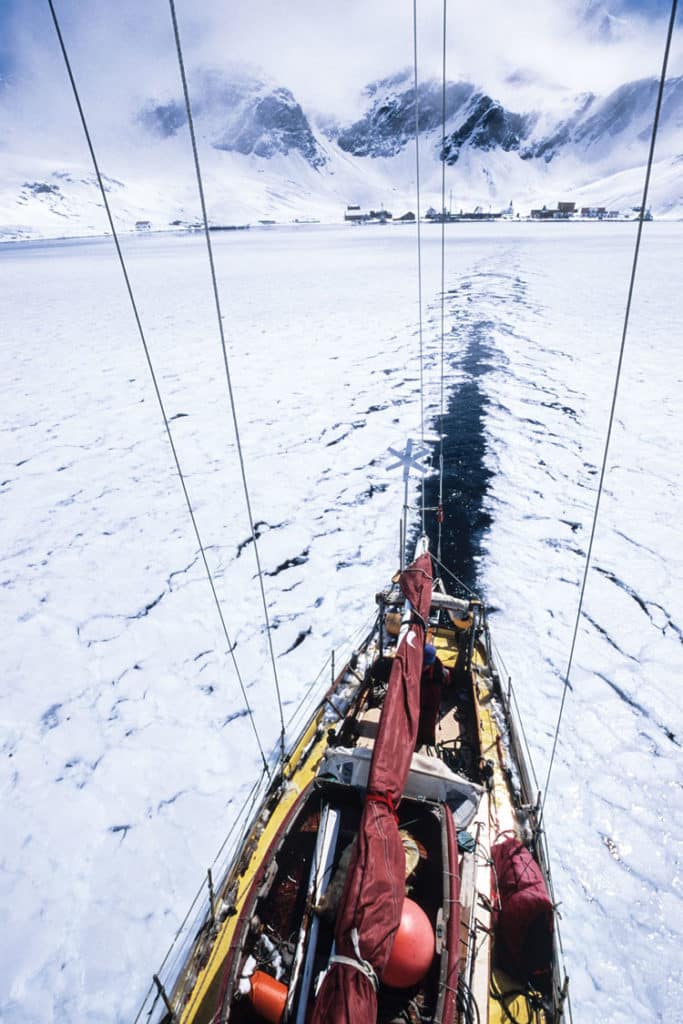
The longer I stayed horizontal, the more consciously I coughed, perhaps a symptom of the impossibility of setting out to sea like this. I did manage a little test sail with friends in Force 6 winds, which caused some alarm ashore due to the boat appearing so low in the water; Wanderer was heavily laden.
Yet neither my feverish cough nor my soft knees would budge. The mental preparation for such a passage begins long before the start, by inwardly playing through all the possible scenarios. But I was shaken. Such a storm-of-the-century would have blown us God knows where, certainly not to South Georgia. My courage was blocked, day after day. What kind of weather was I waiting for? Finally, when the met office produced a decent forecast, my fever left as suddenly as it had appeared. If we didn’t cast off on Thursday, it would turn into Friday. And leaving on a Friday — impossible!
That’s the psychology of such an unscripted voyage. And so, 11 days after the storm, Kicki and I tacked Wanderer, still heavily laden, against a fresh northwest wind through Stanley Harbour’s Narrows. Eight hundred miles of Southern Ocean separated us from an extraordinary adventure and South Georgia. I had prepared myself nautically for the passage, but had not exposed myself to any images of South Georgia. This attitude pervades our sailing: Keep yourself as visually innocent as possible in order to allow the joy of discovery. Instead, I carried dream pictures within me, full of imagined bays and hideaways.
And I was swept away by reality.
Nearly 2 miles high, just over 12 miles wide, 75 miles long and two-thirds covered in permanent ice, the island is as spectacular as a maritime Himalayas. And an ocean Serengeti: 450,000 elephant seals, 4 to 5 million fur seals, endless millions of seabirds; albatross and penguins share a coastline that in summer holds the highest density of birds and mammals in the world.
Such tightly packed pockets of wildlife are precious few on our planet. Nowhere else do ocean and land mingle in such an irresistible way, with such beauty. Our landfall, after days of icebergs and fog, was a burst into magnificence. It touched us like no island ever had. This changed us profoundly.
After three summer months on South Georgia, the grand loop of life didn’t end up taking us back to Europe, as had been envisioned back in Cape Town, but instead led us ever farther into experiencing the high southern latitudes. We could do this because we have the boat, the simplicity and the time. That’s why I sail: to reach out into nature, not for commercial reasons, not to discover the already known, but to experience life and to counteract the tendency to accumulate things. We gather instead experience, wisdom and friendships.
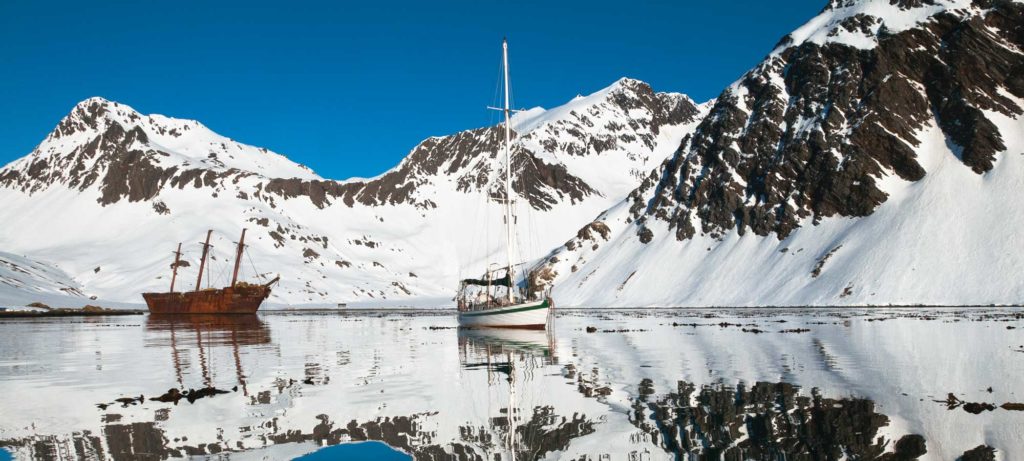
South Georgia became the focal point of 30 deliberately chosen years upon the oceans. It wouldn’t let us go, and in 2009, we returned. This time we didn’t only wish for a summer of animal abundance, but also for an island totally clad in white. We wanted to experience also the winter, an entire year: us, tiny; the island, huge; totally out of this world.
As mentioned, getting to South Georgia is one thing. It’s another thing entirely to endure. The shortest passage from bay to bay is notoriously unpredictable. Winds jump from zero to 100 knots within minutes, and alter their direction unforeseeably. Speeding fog banks can overtake you at the drop of a hat, or similarly, ice will choke a whole bay. Our biggest challenge was to survive in such a place without weather forecasts or a strong engine for out boat.
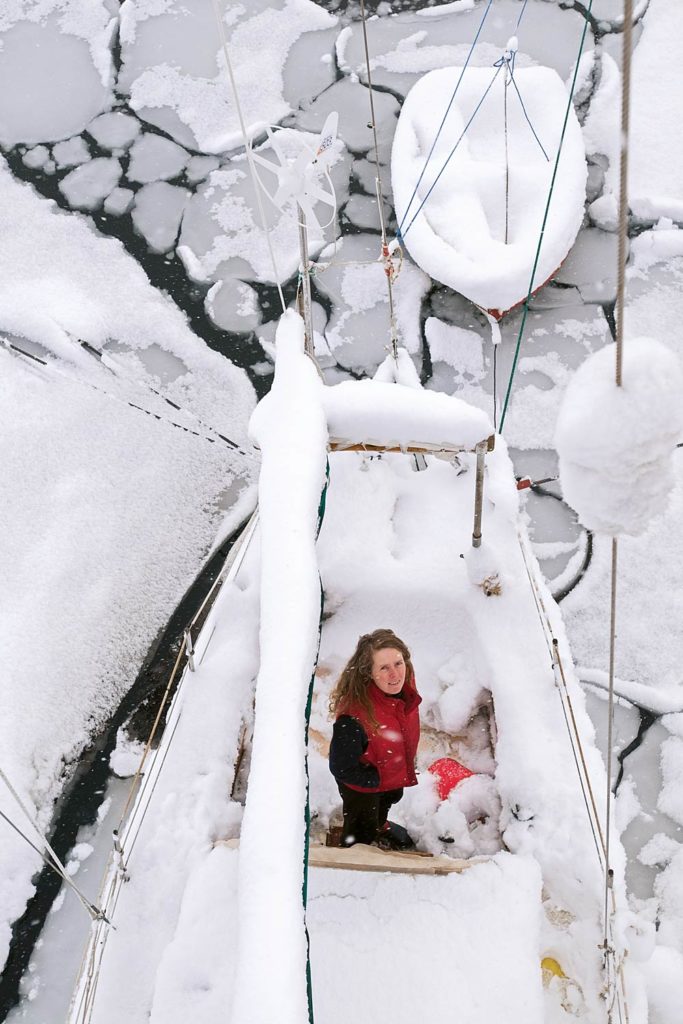
Another was Kicki’s provisioning, since you can’t buy anything on South Georgia. Besides storing everything from flour to lighter cubes to last a year, we also had to find room for skis, crampons and 500 meters of heavy rope on 30 feet of boat. This was a logistical exercise that hardly left room for us. But that was not the only reason we so often sought the outdoors. Whenever possible, we went up into the mountains and off to the animals. When possible, we used muscles rather than wind to hike or ski miles to reach fairy-tale beaches populated by black-white-golden figures: 200,000 king penguins. These were majestic creatures we mingled with. Surrounded by penguin muck we felt filthy rich.
Back on board Wanderer, the animals didn’t let up. Elephant seals visited nonstop. They announced their 4-ton arrival with heavy breathing, and stayed peaceful. First a ruffian would rub along our hull, then a bigger-nosed bull would take a liking to our dinghy. I have little confidence in the compos mentis of these fellows who focused so much attention on our deckside fenders. Their intellectual competence will always lag behind their physical strength. I didn’t like them near our boat, especially not aft at our vulnerable bumpkin stays. I was even less enthusiastic about them 6 inches from my ear, on the other side of the planks, when they roared into Wanderer‘s hull, using the boat as a resonator — well past midnight, every night. Their interest in us seemed inflated, as was my reaction: standing in the companionway with a whistle and a 400,000-candlepower spotlight in a fruitless attempt to deter them.
But at some point, I stopped needing my arsenal. Winter came, and the animal voices left us. What remained was the wail and roar of the wind while we stayed below and fed the wood burner with coal collected ashore. Sometimes the open bays would freeze over, but storms and ocean swell would always break up the ice. So we could sail, and every three months or so, visit the scientific base near Grytviken’s old whaling station.
Outside of Grytviken, we were alone. The island was ours the whole winter. We could reach nobody, and nobody could reach us. On skis we climbed to glaciers and sped back down. Whenever possible, we secured the boat not only to anchors, but also with lines to rocks. If it felt safe to leave Wanderer for a few days, we’d heft our backpacks and tent to cross the magical winter mountain ridges to visit the few remaining winter penguin colonies.
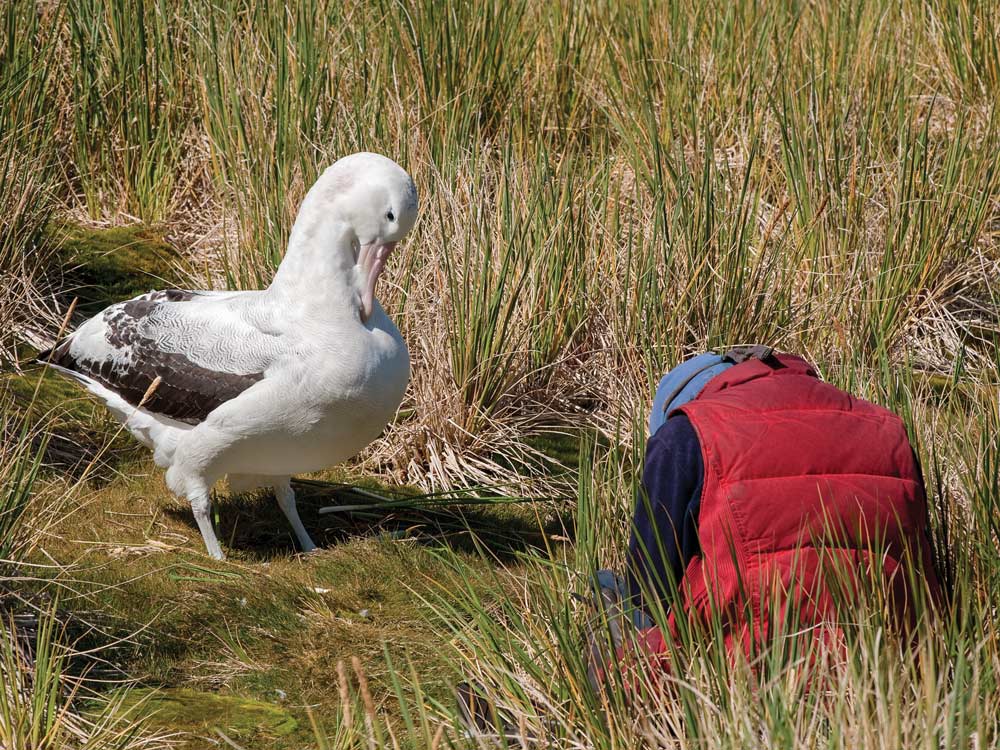
On Wanderer, small as it is, we are always immediately in touch with the elements. They surround us, penetrate us, for better and for worse. The winds positively exploded around us, their intensity at times frightening, at times wonderful, sometimes both at once. And when we were on skis or listening to a leopard seal duet, and these winds suddenly abated — when all fell quiet and the sun reigned again on South Georgia’s sparkling white winter dress — then there was nothing more beautiful. It was the South Georgia we loved.
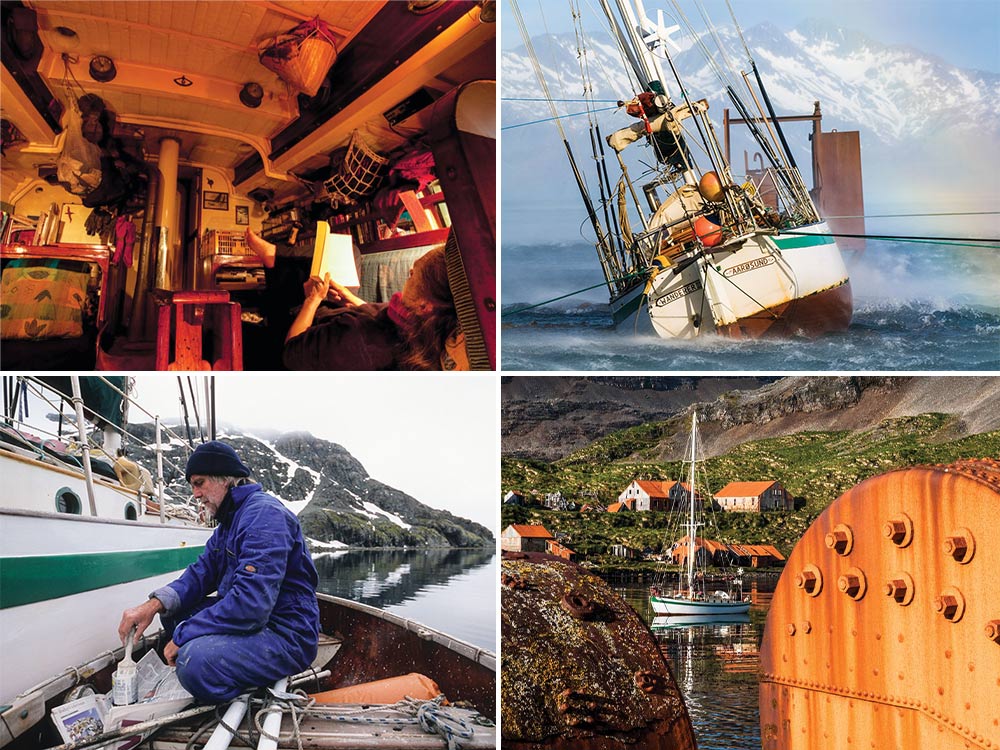
One year was not enough for South Georgia. It’s impossible, in one summer, to be with each species for its relevant breeding season. The more you immerse yourself, the greater the desire for more. We had plenty of firewood. Right at the beginning of our stay, I had offered to dispose of the old jetty timbers in our wood stove. Sometimes we collected a bit of whalers coal in Ocean Harbour. We still had kerosene for cooking, and diesel for our 20-liter tank because our engine is small. We know our monthly food consumption precisely. Multiplied into a year, it adds up to little more than the average First World citizen discards unused. Our organic waste tends toward zero.
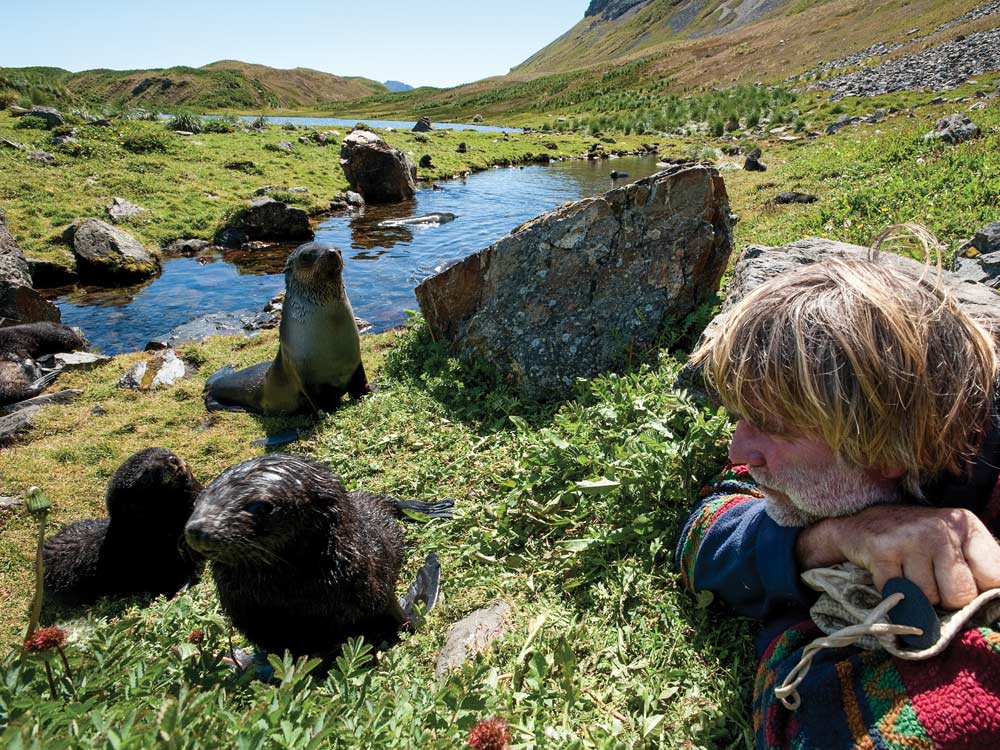
The forepeak, in which we sleep, was our fridge, and kept the breakfast apples fresh. We had beans and seeds for sprouting, and home-pickled meat remaining from an island in the Falklands that we looked after. It was plenty. Kicki’s inventory permitted a second year, as long as our friends on charter yachts brought us the staples: apples, oats, flour, rice, spaghetti, cheese. So we stayed a second winter and a third summer, at the end of which we found ourselves squatting next to a juvenile wandering albatross.
RELATED: Seafaring History: Shackleton Traverses South Georgia Island
All of us, each in our own way, had our thoughts on the inevitable departure. The Southern Ocean awaited us. The bird had never yet flown and, still on his nest, was training his wings in large arcs. Once airborne, he would not return from the nourishing ocean for six to eight years. Nobody was feeding him now. He had to go, couldn’t stay. The impending departure — for him as well as for us — was a leap into uncertainty.
That Kicki and I hesitated was not due to a any clock, not even due to the upcoming stretch of ocean with the world’s highest incidents of storms, but purely because of emotions. After precariously learning how to stay, we found it nearly impossible to leave.
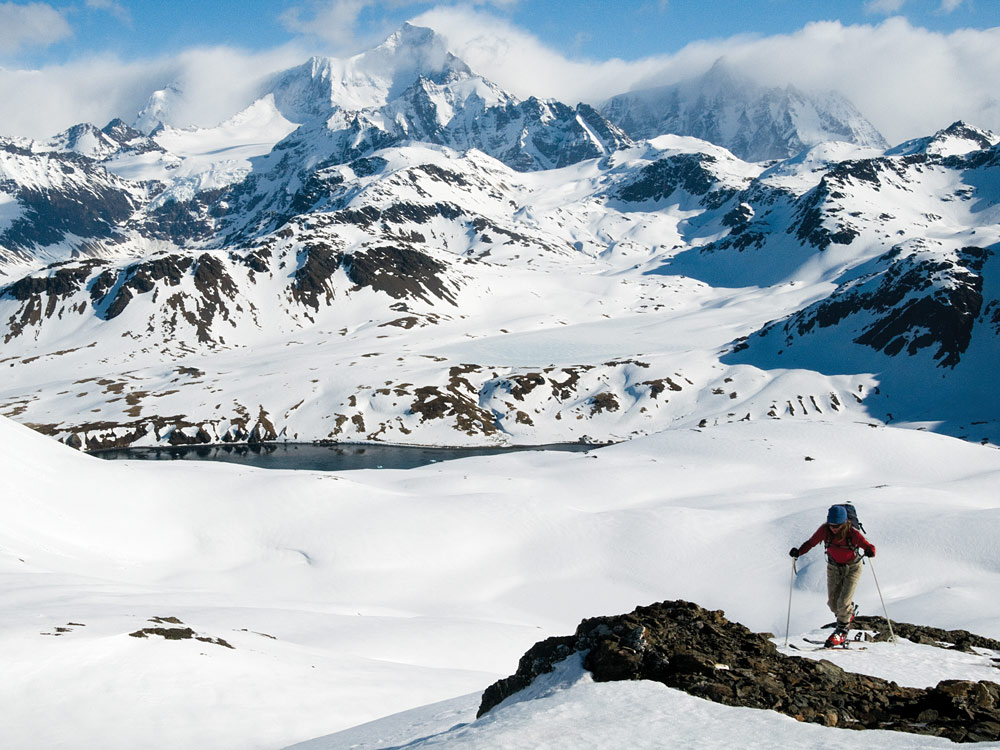
Nevertheless, leave we did, while things were good, and with a stadium-style Mexican wave from Grytviken’s bay. Distress-flare smoke shrouded the British research base. Everyone ashore threw up their arms. Slowly the promontory with Sir Ernest Shackleton’s cross moved between us and them. We were left in tears — and initially were windless. Then northwesterlies and fog swallowed us as we sailed, knowing there was iceberg risk in the first 300 nautical miles. At first, during the second double-reefed day of bucking headwinds, two weeks looked like an eternity. In retrospect, on day 14, it seemed frighteningly brief. Time melted. Meanwhile, we had reached 40 degrees south, and in light winds, as if on tiptoe, approached Tristan da Cunha for the second attempt at a landing, many years after the first. Sadly, our arrival coincided with a storm warning.
When it came, it took our windvane and blew us northward under bare poles, toward St. Helena. All of a sudden, we had to pump the bilge 80 strokes every few hours — way too much for Wanderer.
I checked aft, under the cockpit, in the galley, the seacocks and, though skeptically, also the keel bolts. They had never, ever leaked. To sort out the forepeak was nearly impossible, as stuffed as it was with sails, fenders, the table, rope and the small tire we use for our drogue. Right at the stem: a little trickle, not more or less than normal. It’s been there for years, the only one I know of. Under the forepeak floor: dry. By the head, dry also. This post-traumatic leak was as mysterious as my post-traumatic fever back in Stanley.
However, in better light, the damp up forward betrayed movement. Water must be coming from the head after all. I touched the bronze seacocks again: dry, or? Hold on, my fingers got wet. That’s when I turned the conical seacock: It was incredibly loose. In South Georgia I had hardly been able to move it; in the cold it had been tight, but not so now. With every plunge of the bow, a small jet of water shot into the boat. Slowly, I understood: the grease! It had gotten soft like butter in the heat. Kicki handed me a screwdriver, and I tightened two little bolts. That was it. After 26 months on the most breathtaking island, we were now worry-free. It was warm.
Thies Matzen and Kicki Ericson are winners of the Cruising Club of America’s Blue Water Medal. They have been roaming the world’s oceans for over two decades aboard *Wanderer III, which has earned the Blue Water Medal twice.*








